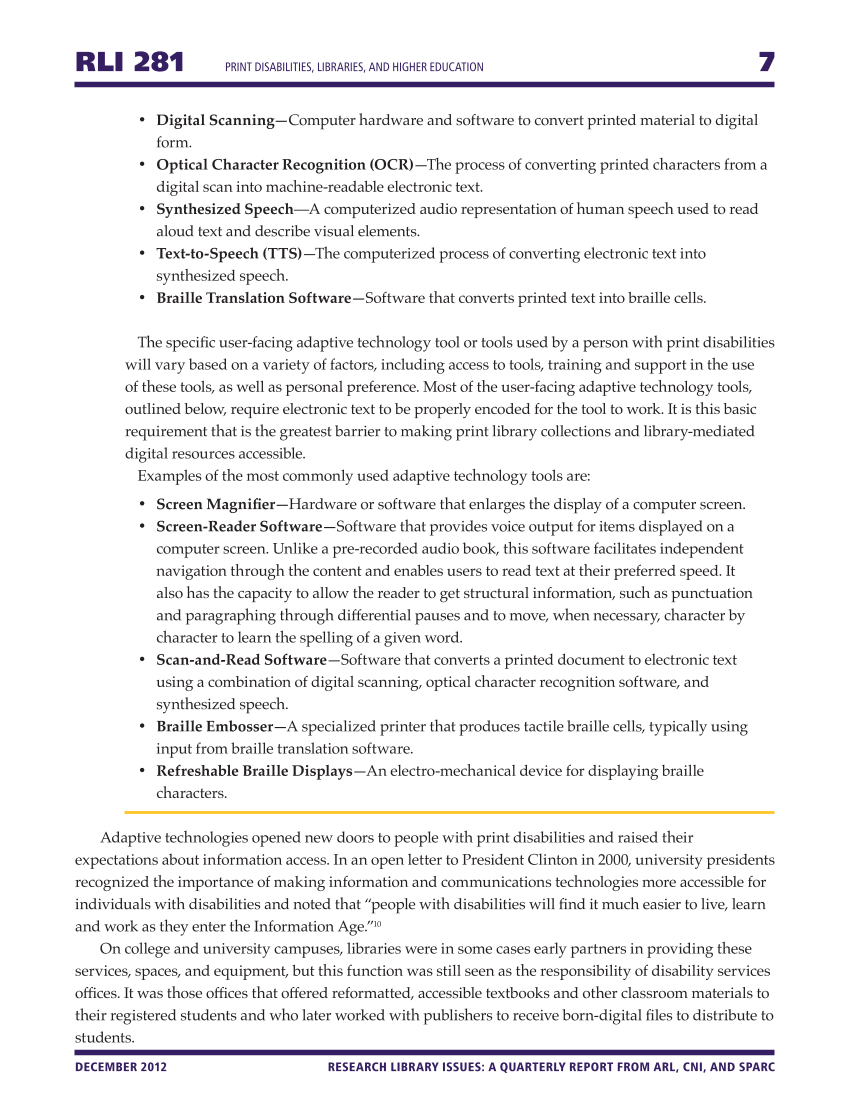RLI 281 Print DisabilitiesS, LibrariesS, and Higher Education 7 DECEMBER 2012 RESEARCH LIBRARY ISSUES: A QUARTERLY REPORT FROM ARL, CNI, AND SPARC • Digital Scanning—Computer hardware and software to convert printed material to digital form. • Optical Character Recognition (OCR)—The process of converting printed characters from a digital scan into machine-readable electronic text. • Synthesized Speech—A computerized audio representation of human speech used to read aloud text and describe visual elements. • Text-to-Speech (TTS)—The computerized process of converting electronic text into synthesized speech. • Braille Translation Software—Software that converts printed text into braille cells. The specific user-facing adaptive technology tool or tools used by a person with print disabilities will vary based on a variety of factors, including access to tools, training and support in the use of these tools, as well as personal preference. Most of the user-facing adaptive technology tools, outlined below, require electronic text to be properly encoded for the tool to work. It is this basic requirement that is the greatest barrier to making print library collections and library-mediated digital resources accessible. Examples of the most commonly used adaptive technology tools are: • Screen Magnifier—Hardware or software that enlarges the display of a computer screen. • Screen-Reader Software—Software that provides voice output for items displayed on a computer screen. Unlike a pre-recorded audio book, this software facilitates independent navigation through the content and enables users to read text at their preferred speed. It also has the capacity to allow the reader to get structural information, such as punctuation and paragraphing through differential pauses and to move, when necessary, character by character to learn the spelling of a given word. • Scan-and-Read Software—Software that converts a printed document to electronic text using a combination of digital scanning, optical character recognition software, and synthesized speech. • Braille Embosser—A specialized printer that produces tactile braille cells, typically using input from braille translation software. • Refreshable Braille Displays—An electro-mechanical device for displaying braille characters. Adaptive technologies opened new doors to people with print disabilities and raised their expectations about information access. In an open letter to President Clinton in 2000, university presidents recognized the importance of making information and communications technologies more accessible for individuals with disabilities and noted that “people with disabilities will find it much easier to live, learn and work as they enter the Information Age.”10 On college and university campuses, libraries were in some cases early partners in providing these services, spaces, and equipment, but this function was still seen as the responsibility of disability services offices. It was those offices that offered reformatted, accessible textbooks and other classroom materials to their registered students and who later worked with publishers to receive born-digital files to distribute to students.



































